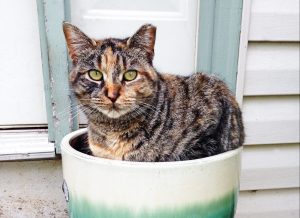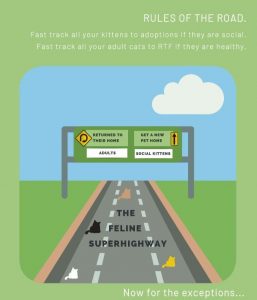Module 4: The Case of the Spay-Neuter Skeptic
Targeted Programs for Community Cats
Community Cat Management

Shelter Snapshot: Questions About Community Cat Programs?
By Dr. Erin Katribe
Hundreds of thousands of cats are losing their lives in our nation’s shelters every year, simply because there aren’t enough homes for them. Bird populations are declining, too, because of the impact of humans and development.
What if there were a single solution that could help address both of these issues, one that satisfied cat lovers and wildlife aficionados alike? In reality, we already have this solution—it’s community cat programming, and recent research is showing that targeted programs can achieve what both sides want.
Let’s look at some common questions regarding community cat programs and what the research shows. Read more . . .
community cat management superhighways
Across the US, cats are both taken into shelters in higher numbers than dogs and are euthanized in greater proportions. As a result, cats in shelters have a higher risk of a poor outcome. It is estimated that 30 million owned and 30-90 million unowned cats in the US are free-roaming. Given that more than 80% of owned cats are sterilized, community cats (unowned or loosely owned free-roaming cats) are likely to be the single largest source of new kittens and shelter cat intakes. Overcrowding of cats in shelters combined with the fact that many free-roaming cats already have a home (either with a traditional owner or as a neighborhood cat) calls for a more nuanced approach than simply bringing cats to shelters. A comprehensive approach to reducing feline intake and euthanasia involves a combination of trap-neuter-return and adoption.
Pathway Planning for Community Cats

No two shelters or cats are the same and how to manage a shelter’s most vulnerable population varies by community. Read the complete Million Cat Challenge Pathway Planning: What to Do with All of These Cats superhighway roadmap for a comprehensive plan that takes the guesswork out of cat management decision-making and identifies the best outcomes for cats, neighborhoods, and shelters.
Friendly kittens (< 6 months of age)
The superhighway, or preferred outcome, for friendly kittens is to a pet home. Friendly kittens are likely to adapt well to life as a pet, and filling homes in our communities with friendly, happy, healthy, sterilized, vaccinated pets is part of the mission of shelters. Kittens by definition have been born within the current breeding cycle, and therefore are not as likely as older cats to already be adapted to the environment of origin and occupying an ecologically important niche. The food source that their parent accessed may not be adequate to support another generation of cats, and removing these immature cats is not likely to trigger the immigration or increased breeding associated with removing mature adults. Read the complete roadmap for reasons why some kittens might exit the adoption superhighway.
Healthy free-roaming adult cats (> 6 months of age)
Whether feral or friendly, mature cats in good body condition are by definition occupying a niche in the community, and removal raises the risk of increased breeding or translocation of cats remaining in the community, thereby increasing risks to cats, public health and wildlife. In many shelters there are still abundant adult cats that truly need pet homes (owner surrendered cats, sick and injured cats, victims of cruelty and neglect, cats that can’t go back to the location of origin) and fast tracking healthy cats that are doing fine back through RTF/TNR will reserve homes for those truly in need. It is often surprising the cats that turn out to be ‘adoptable’ when they are not competing with 50 other friendly healthy cats; even shy, older cats and those with medical challenges can be adopted when there is less competition. Mature feral cats are not candidates to become pets. Relocation is resource intensive and has a high failure rate, leading to risks for relocated cats. Limited relocation sites (working cat homes) should be reserved for cats that can’t be returned. Read the complete roadmap for reasons why some adult cats might exit the return-to-neighborhood superhighway.

